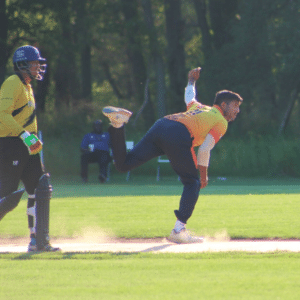Steve Steinberg of CricAmerica is back with Cricket Stats 101, sharing insights on the statistics behind cricket. Part two focuses on bowling statistics, so if you love MLB pitcher or NFL quarterback stats, this one is for you!
As we saw in our look at batting statistics, the importance of various numbers and equations depends on the format of the game being played. Stats that may be the Gold Standard for comparing players in Test cricket may be less helpful — or almost useless — for comparing players in T20. And that holds true for bowling stats, as well.
When it comes to bowling, there are three numbers to pay attention to: wickets taken, runs allowed, and balls (or overs) bowled. Armed with these numbers, you can get a pretty good feel what a bowler can do. And, conveniently, these three figures are the main players in an important round-robin of bowling statistics.
Bowling Average is the number of runs allowed per wicket. Bowling Strike Rate is the number of balls bowled per wicket. And Bowling Economy is the number of runs allowed per over (or per every six balls bowled).
In the days when Test cricket was the only game in town, Bowling Average (like Batting Average for Batsmen) was considered the strongest way to compare two bowlers. You could look at their numbers and see who gave up the fewest runs for each wicket taken. It was an easy way to have quantitative proof that one bowler was better and more efficient at getting guys out.
Similarly, Strike Rate also gave number-crunchers a way to compare bowlers’ speed and effectiveness in taking wickets. While it ignored how many runs a bowler may have given up, it did serve as a reliable barometer on how frequently you could expect a bowler to take a wicket.
The rise of limited overs matches — especially T20 — made both of these stats a little less relevant. While it was great to be able to take wickets while giving up as few runs — and using as few deliveries — as possible, the nature of the shorter game altered what was really important for a bowler. All of a sudden, taking wickets wasn’t as much of a priority as just keeping the batting side from scoring a lot of runs.

“In T20 cricket, wickets are less valuable than in 50-over or Test cricket because of the shorter innings,” says Major League Cricket’s stats guru, Tom Nielsen. “It’s a lot easier for the batting side to survive the full innings, so you’re usually not going to bowl out the opposition. With just 120 deliveries, there’s pressure for the batters to do something with every delivery, and dot balls (balls in which the batting side doesn’t score) are really important in restricting totals of the opposition. So, if you’re a bowler putting up a lot of dot balls, that’s building pressure and keeping opponent’s scores down.”
The main point is that in Test cricket, your bowlers need to be able to get wickets. If they can’t get ten wickets, not only can’t they win, they — literally — can’t even play a legal game (unless the batting team declares early in both its innings). In T20, like the matches played in Minor League Cricket and eventually Major League Cricket, not only can you play without bowling out the other side, you can — and will — actually win. Looking at the most recent Minor League Cricket season, the Silicon Valley Strikers won the championship, yet their bowling attack only bowled out the opposition in four of 18 matches. And in the IPL, the point is made even louder and clearer. MS Dhoni’s Chennai Super Kings took home the title while bowling out only one of its opponents in 16 matches.
With less focus on taking wickets and more focus on limiting the number of runs allowed, a new formula was needed to determine and compare the relative skills of bowlers.
And that’s where Bowling Economy comes in. It measures how many runs a bowler allows per over and ignores wickets completely. (That isn’t to say that taking wickets isn’t important. Any time you can send an Andre Russell, Virat Kohli, or Mohammad Rizwan back to the pavilion, you’ve done something big. The difference is that in Test cricket, eventually you get to the weaker late-order batters. In T20, the limited number of balls means you probably won’t bowl deep into the order, so that even if you take a wicket, the next batter coming in is still capable of doing some damage.)
 You can almost think of Bowling Economy as being the flipside to Strike Rate for batters, which we covered in Part One of this series. Where batting Strike Rate measured how many run a batter scores per hundred balls (or per ball if you divide by 100), Bowling Economy measures how many runs a bowler allows per over (or per ball if you divide by six).
You can almost think of Bowling Economy as being the flipside to Strike Rate for batters, which we covered in Part One of this series. Where batting Strike Rate measured how many run a batter scores per hundred balls (or per ball if you divide by 100), Bowling Economy measures how many runs a bowler allows per over (or per ball if you divide by six).
Bowling Economy is also a very user-friendly stat for figuring out how good a bowler is and how he might affect a T20 match. Let’s assume a typical T20 score is around 150. This breaks down to 7.5 runs that the batting side is scoring per over (150 divided by 20). If a bowler has an economy of 6.5, he’s allowing a full run less per over than the average. For the most part, a Bowling Economy under 7.0 is considered pretty strong and anything under 6.5 should put you in the league leaders. (Due to the slightly lower average scores in the past Minor League Cricket season, Bowling Economies skewed a little lower than in most T20 leagues. Look for a natural correction in that going forward as there becomes more parity between teams.)
For newcomers to cricket, one of the toughest concepts to wrap the brain around is the idea of wickets. What are they? What’s their role? What does “taking a wicket” mean? There’s no real equivalent to these stumps and bails in any other sport played in this country. Ironically, the most telling bowling stat for the most popular version of the sport being played right now ignores this hardware altogether. So, if you’re grabbing bowlers for your IPL, CPL, or BBL fantasy team — and, someday, your Major League Cricket fantasy team — keep your eye on Bowling Economy and choose wisely!




